On the one introduced parsing mark, equivalent to identifying the sentence, what words, the next is to take these words to form a complete sentence, that assembly marked the syntax tree.
Tree (tree)
Tree data structure is a computer terminology. Like a lot of school grades, each grade below a lot of classes, each class many students below, this organizational structure is called a tree.
- Each part of the tree is called a node (the Node);
- Topmost node (i.e. school example) is called the root node (Root Node);
- Child nodes and lower nodes each node is called the node (Child Node, do not call attention Subnode) (grade class is a child node);
- In turn, the parent node of each node is called the parent node of this node (Parent node) (Grade is the parent class);
- Child node and child node child node is referred to as a descendant node of the node (Descendant node);
- Parent and the parent's parent node is referred to as a grandparent node of this node (Ancestor node).
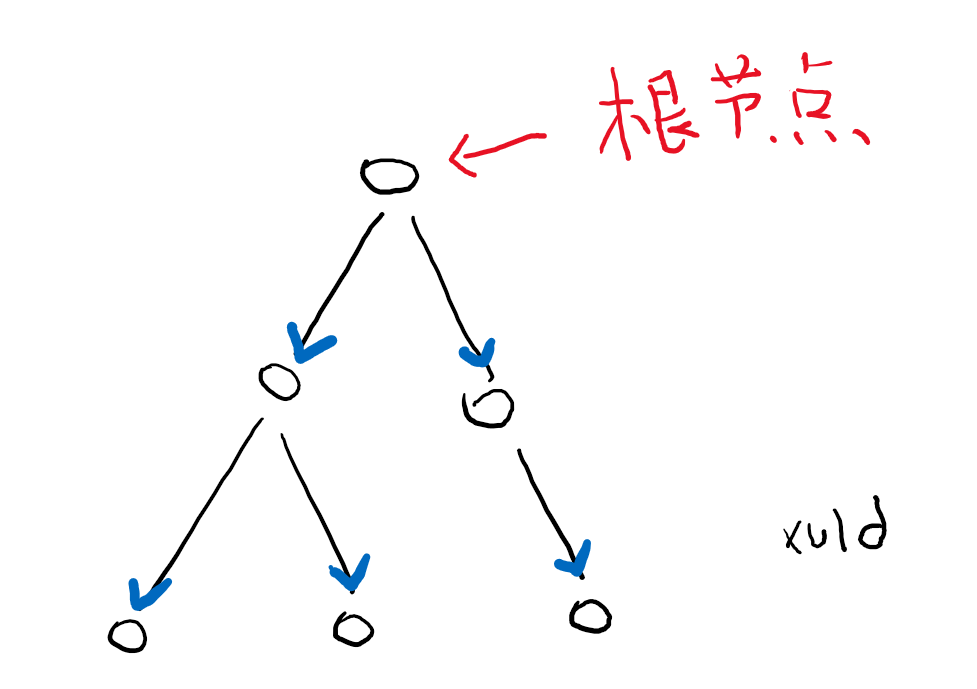
Many people think of a binary tree mention, explain what you did not know what a tree. Binary tree is just a tree. Binary tree is used in most places in the papers, please forget the word.
From either a node in the tree, you can traverse all of the descendants of this node. Because the node does not recycle relationship, so it traverses the tree will not infinite loop.
There node traversal order there are many, if not specifically stated, in accordance Fathers node, then the child nodes, the left to right sibling nodes (numbered in the sequence diagram).
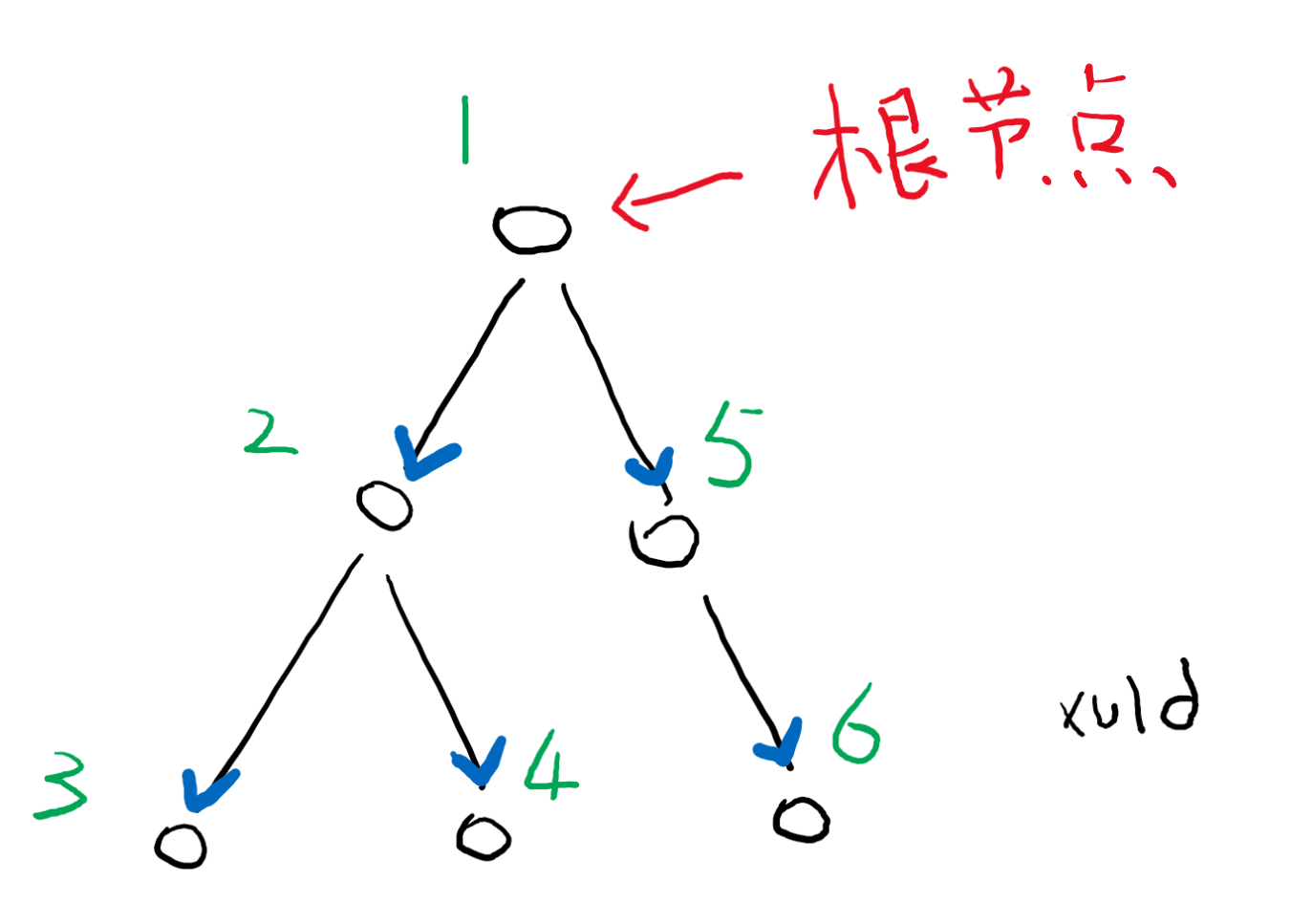
Syntax tree (Syntax Tree)
Syntax tree for the structure of the code tree with the following analytical representation.
For example the following code syntax parse tree of FIG:
var x = ['l', [100]]
if (x) {
foo(x)
}
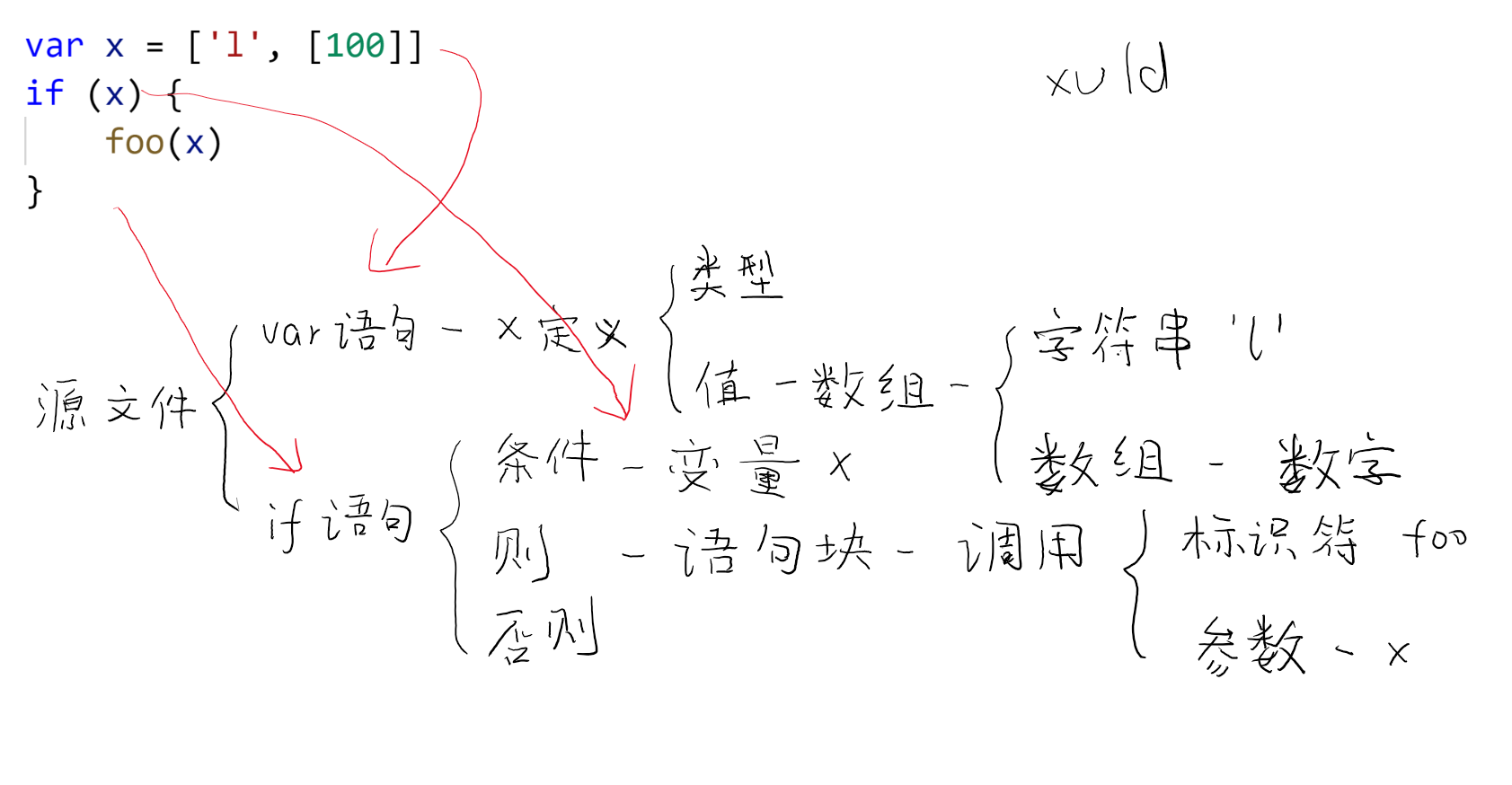
Among them, the source file (Source File) is the root of the syntax tree.
There are many types of syntax tree nodes, depending on the species, the type of child nodes of these nodes will change. such as:
- “if 语句”节点,只有“条件表达式”、“则部分”和“否则部分”(可能为空)三个子节点。
- “双目表达式(x + y)”节点,只有“左值表达式”和“右值表达式”两个子节点。
TypeScript 中,节点有约 100 种,它们都继承 “Node” 接口:
export interface Node extends TextRange {
kind: SyntaxKind;
flags: NodeFlags;
parent: Node;
// ...(略)
}
Node 接口中 kind 枚举用于标记这个节点的种类。
TypeScript 将表示标记种类的枚举和表示节点种类的枚举合并成一个了(这可能也是导致很多人读不懂代码的原因之一):
export const enum SyntaxKind {
// ...(略)
TemplateSpan,
SemicolonClassElement,
// Element
Block,
EmptyStatement,
VariableStatement,
ExpressionStatement,
IfStatement,
DoStatement,
WhileStatement,
ForStatement,
ForInStatement,
ForOfStatement,
ContinueStatement,
BreakStatement,
// ...(略)
}
如果你深知“学而不思则罔”的道理,现在应该会思考这样一个问题:那到底有哪 100 种语法节点呢?
这里先推荐一个工具:https://astexplorer.net/
这个工具可以在左侧输入代码,右侧查看实时生成的语法树(以 JSON 方式展示)。读者可以在这个工具顶部选择“JavaScript”语言和“typescript”编译器,查看 TypeScript 生成的语法树结构。
为了帮助英文文盲们更好地理解语法类型,读者可参考:https://github.com/meriyah/meriyah/wiki/ESTree-Node-Types-Table
语法节点分类
虽然语法节点种类很多,但其实只有四类:
- 类型节点(Type Node):一般出现在“:”后面(var a: 类型节点),可以解析为一个类型。
- 表达式节点(Expression):可以计算得到一个值的节点,表达式节点只能依附于一个语句节点,不能独立使用。
- 语句节点(Statement):可以直接在最外层使用的节点,俗称的几行代码就是指几个语句节点。
- 其它节点:其它内嵌在表达式或语句节点的特定节点,比如 case 节点。
在 TypeScript 中,节点命名比较规范,一般类型节点以 TypeNode 结尾;表达式节点以 Expression 结尾;语句节点以 Statement 结尾。
比如 if 语句节点:
export interface IfStatement extends Statement {
kind: SyntaxKind.IfStatement;
expression: Expression;
thenStatement: Statement;
elseStatement?: Statement;
}
鉴于有些读者对部分语法比较陌生,这里可以说明一些可能未正确理解的节点类型
表达式语句(ExpressionStatement)
export interface ExpressionStatement extends Statement, JSDocContainer {
kind: SyntaxKind.ExpressionStatement;
expression: Expression;
}
表达式是不能直接出现在最外层的,但以下代码是允许的:
var x = 1;
1 + 1; // 这是表达式
因为 1 + 1 是表达式,它们同时又是一个表达式语句。所以以上代码的语法树如图:
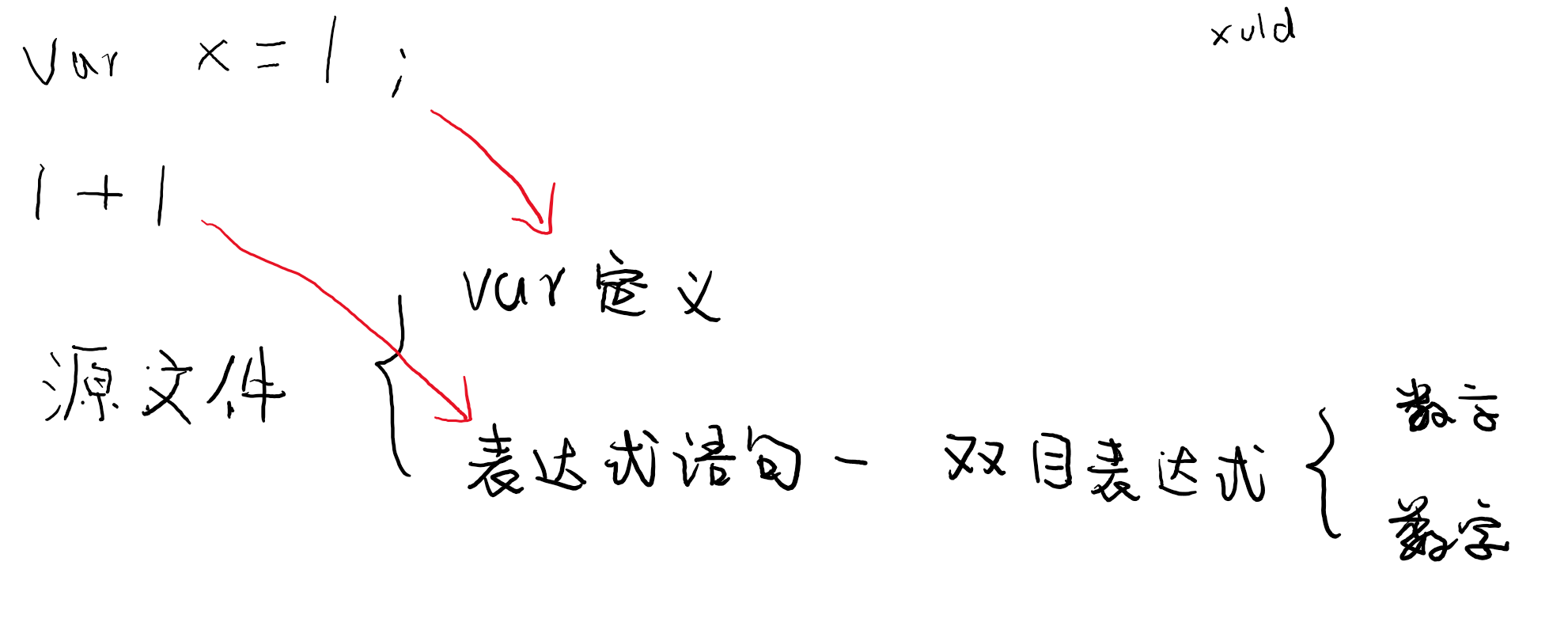
常见的赋值、函数调用语句都其实是一个表达式语句。
块语句(BlockStatement)
一对“{}”本身也是一个语句,称为块语句。一个块语句可以包含若干个语句。
export interface Block extends Statement {
kind: SyntaxKind.Block;
statements: NodeArray<Statement>;
/*@internal*/ multiLine?: boolean;
}
比如 while 语句的主体只能是一条语句:
export interface IterationStatement extends Statement {
statement: Statement;
}
export interface WhileStatement extends IterationStatement {
kind: SyntaxKind.WhileStatement;
expression: Expression;
}
但 while 里面明明是可以写很多语句的:
while(x_d) {
var a = 120;
var b = 100;
}
本质上,当我们使用 {} 时,就已经使用了一个块语句,while 的主体仍然是一个语句:块语句。其它语句都是块语句的子节点。
标签语句(LabeledStatement)
export interface LabeledStatement extends Statement, JSDocContainer {
kind: SyntaxKind.LabeledStatement;
label: Identifier;
statement: Statement;
}
通过标签语句可以为语句命名,比如:
label: var x = 120;
命名后有啥用?可以在 break 或 continue 中引用该名称,以此实现跨级 break 和 continue 的效果:
export interface BreakStatement extends Statement {
kind: SyntaxKind.BreakStatement;
label?: Identifier; // 跳转的标签名
}
export interface ContinueStatement extends Statement {
kind: SyntaxKind.ContinueStatement;
label?: Identifier; // 跳转的标签名
}
运算符的优先级
比如 x + y * z 中,需要先算乘号。生成的语法树节点如下:
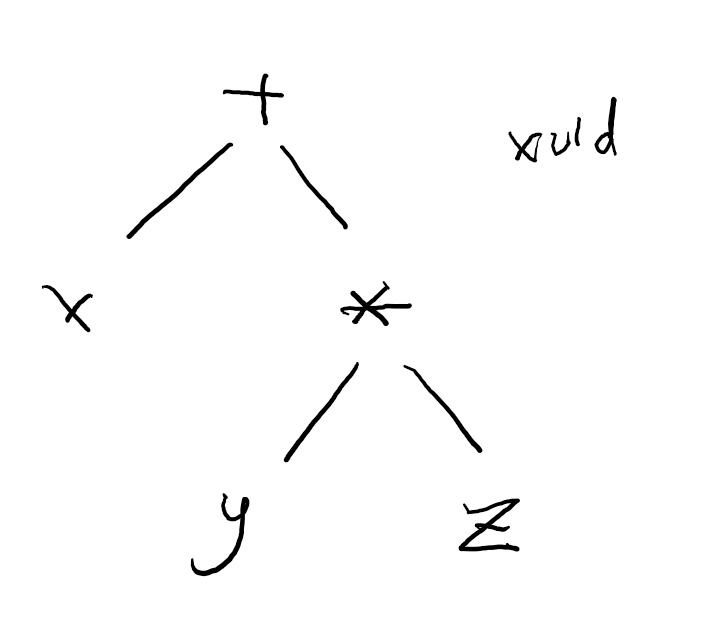
通过节点的层次关系,实现了这种优先级的效果(因为永远不会把图里的 x 和 y 先处理)。
因此创建语法树的同时,也就处理了优先级的问题,括号完全可以从语法树中删除。
类
一个复杂的类,也能用语法树表示?
当然,任何语法最后都是用语法树表达的,只不过类确实复杂一些:
export interface Declaration extends Node {
_declarationBrand: any;
}
export interface NamedDeclaration extends Declaration {
name?: DeclarationName;
}
export interface ClassLikeDeclarationBase extends NamedDeclaration, JSDocContainer {
kind: SyntaxKind.ClassDeclaration | SyntaxKind.ClassExpression;
name?: Identifier;
typeParameters?: NodeArray<TypeParameterDeclaration>;
heritageClauses?: NodeArray<HeritageClause>; members: NodeArray<ClassElement>; } export interface ClassDeclaration extends ClassLikeDeclarationBase, DeclarationStatement { kind: SyntaxKind.ClassDeclaration; /** May be undefined in `export default class { ... }`. */ name?: Identifier; }
类、函数、变量、导入声明严格意义上是独立的一种语法分类,但鉴于它和其它语句用法一致,为了便于理解,这里把声明作语句的一种看待。
节点位置
当源代码被解析成语法树后,源代码就不再需要了。如果后续流程发现一个错误,编译器需要向用户报告,并指出错误位置。
为了可以得到这个位置,需要将节点在源文件种的位置保存下来:
export interface TextRange {
pos: number;
end: number;
}
export interface Node extends TextRange {
kind: SyntaxKind;
flags: NodeFlags;
parent: Node;
// ...(略)
}
通过节点的 parent 可以找到节点的根节点,即所在的文件;通过节点的 pos 和 end 可以确定节点在源文件的行列号(具体已经在第二节:标记位置 中介绍)。
遍历节点
为了方便程序中遍历任意节点,TypeScript 提供了一个工具函数:
/**
* Invokes a callback for each child of the given node. The 'cbNode' callback is invoked for all child nodes
* stored in properties. If a 'cbNodes' callback is specified, it is invoked for embedded arrays; otherwise,
* embedded arrays are flattened and the 'cbNode' callback is invoked for each element. If a callback returns
* a truthy value, iteration stops and that value is returned. Otherwise, undefined is returned.
*
* @param node a given node to visit its children
* @param cbNode a callback to be invoked for all child nodes
* @param cbNodes a callback to be invoked for embedded array
*
* @remarks `forEachChild` must visit the children of a node in the order
* that they appear in the source code. The language service depends on this property to locate nodes by position.
*/
export function forEachChild<T>(node: Node, cbNode: (node: Node) => T | undefined, cbNodes?: (nodes: NodeArray<Node>) => T | undefined): T | undefined {
if (!node || node.kind <= SyntaxKind.LastToken) {
return;
}
switch (node.kind) {
case SyntaxKind.QualifiedName: return visitNode(cbNode, (<QualifiedName>node).left) || visitNode(cbNode, (<QualifiedName>node).right); case SyntaxKind.TypeParameter: return visitNode(cbNode, (<TypeParameterDeclaration>node).name) || visitNode(cbNode, (<TypeParameterDeclaration>node).constraint) || visitNode(cbNode, (<TypeParameterDeclaration>node).default) || visitNode(cbNode, (<TypeParameterDeclaration>node).expression); case SyntaxKind.ShorthandPropertyAssignment: return visitNodes(cbNode, cbNodes, node.decorators) || visitNodes(cbNode, cbNodes, node.modifiers) || visitNode(cbNode, (<ShorthandPropertyAssignment>node).name) || visitNode(cbNode, (<ShorthandPropertyAssignment>node).questionToken) || // ...(略) } }
forEachChild 函数只会遍历节点的直接子节点,如果用户需要递归遍历所有子节点,需要递归调用 forEachChild。forEachChild 接收一个函数用于遍历,并允许用户返回一个 true 型的值并终止循环。
小结
掌握语法树是掌握整个编译系统的基础。你应该可以深刻地知道语法树的大概样子,并清楚每种语法的语法树结构。如果还没有彻底掌握,可以使用上文推荐的工具。
下一节将介绍生成语法树的全过程。【不定时更新】